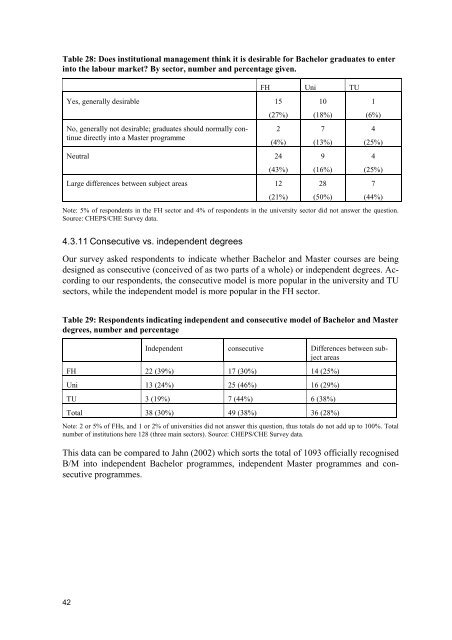and Master Programmes in German Higher Education Institutions
and Master Programmes in German Higher Education Institutions
and Master Programmes in German Higher Education Institutions
- No tags were found...
You also want an ePaper? Increase the reach of your titles
YUMPU automatically turns print PDFs into web optimized ePapers that Google loves.
Table 28: Does <strong>in</strong>stitutional management th<strong>in</strong>k it is desirable for Bachelor graduates to enter<strong>in</strong>to the labour market? By sector, number <strong>and</strong> percentage given.Yes, generally desirable 15(27%)No, generally not desirable; graduates should normally cont<strong>in</strong>uedirectly <strong>in</strong>to a <strong>Master</strong> programmeFH Uni TU2(4%)Neutral 24(43%)Large differences between subject areas 12(21%)10(18%)7(13%)9(16%)28(50%)1(6%)4(25%)4(25%)7(44%)Note: 5% of respondents <strong>in</strong> the FH sector <strong>and</strong> 4% of respondents <strong>in</strong> the university sector did not answer the question.Source: CHEPS/CHE Survey data.4.3.11 Consecutive vs. <strong>in</strong>dependent degreesOur survey asked respondents to <strong>in</strong>dicate whether Bachelor <strong>and</strong> <strong>Master</strong> courses are be<strong>in</strong>gdesigned as consecutive (conceived of as two parts of a whole) or <strong>in</strong>dependent degrees. Accord<strong>in</strong>gto our respondents, the consecutive model is more popular <strong>in</strong> the university <strong>and</strong> TUsectors, while the <strong>in</strong>dependent model is more popular <strong>in</strong> the FH sector.Table 29: Respondents <strong>in</strong>dicat<strong>in</strong>g <strong>in</strong>dependent <strong>and</strong> consecutive model of Bachelor <strong>and</strong> <strong>Master</strong>degrees, number <strong>and</strong> percentageIndependent consecutive Differences between subjectareasFH 22 (39%) 17 (30%) 14 (25%)Uni 13 (24%) 25 (46%) 16 (29%)TU 3 (19%) 7 (44%) 6 (38%)Total 38 (30%) 49 (38%) 36 (28%)Note: 2 or 5% of FHs, <strong>and</strong> 1 or 2% of universities did not answer this question, thus totals do not add up to 100%. Totalnumber of <strong>in</strong>stitutions here 128 (three ma<strong>in</strong> sectors). Source: CHEPS/CHE Survey data.This data can be compared to Jahn (2002) which sorts the total of 1093 officially recognisedB/M <strong>in</strong>to <strong>in</strong>dependent Bachelor programmes, <strong>in</strong>dependent <strong>Master</strong> programmes <strong>and</strong> consecutiveprogrammes.42
















